Photo Contest 2022
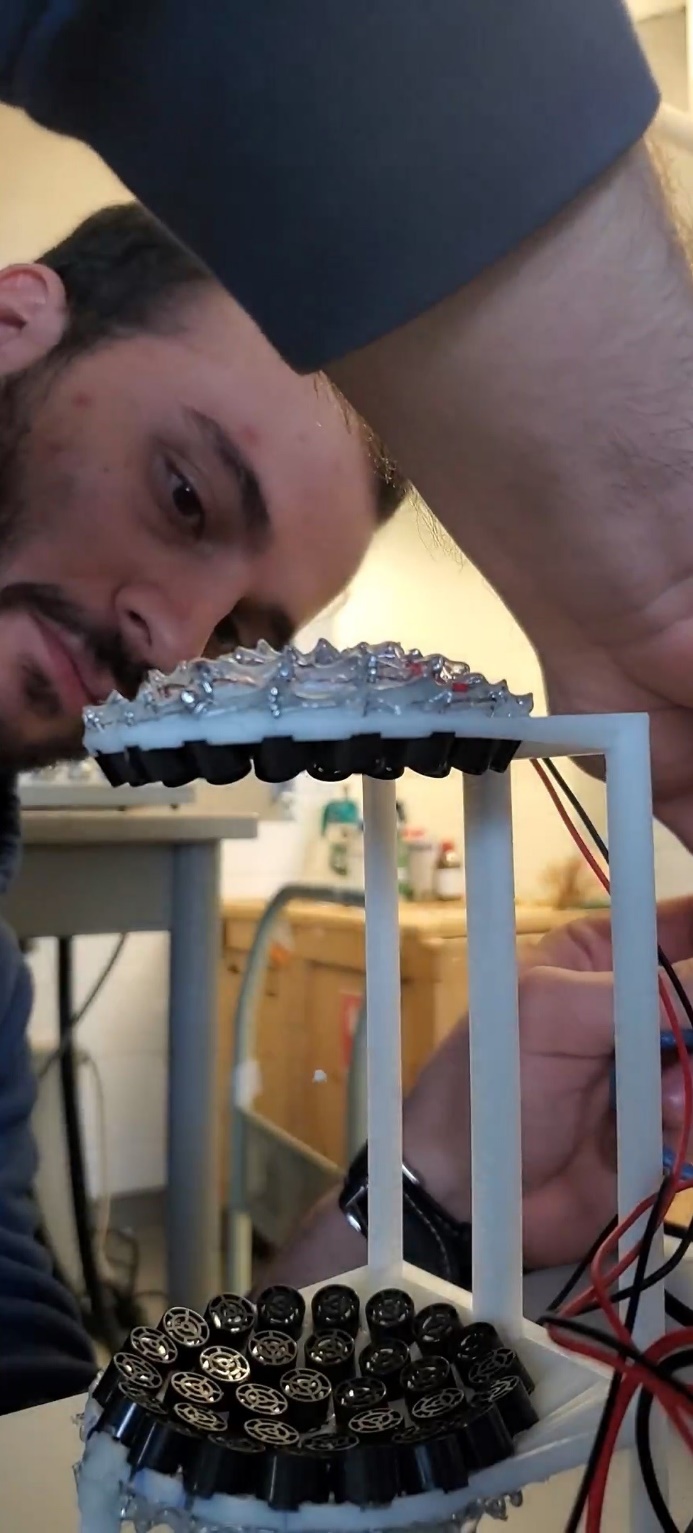
Using the acoustic levitator, an object was levitated in the air. I used the levitator to eliminate the need for a particle shooter.
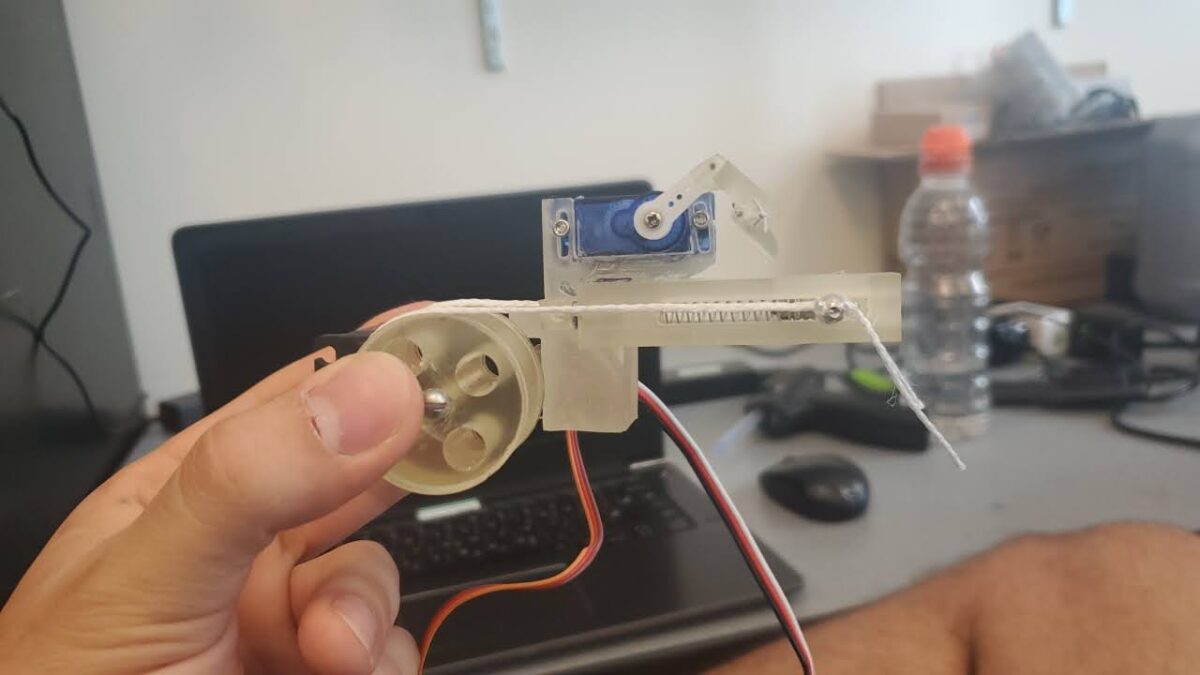
It shoots small particles toward the leading edge of a rotating wing with a thickness of 1 cm and a speed of 60 m/s.
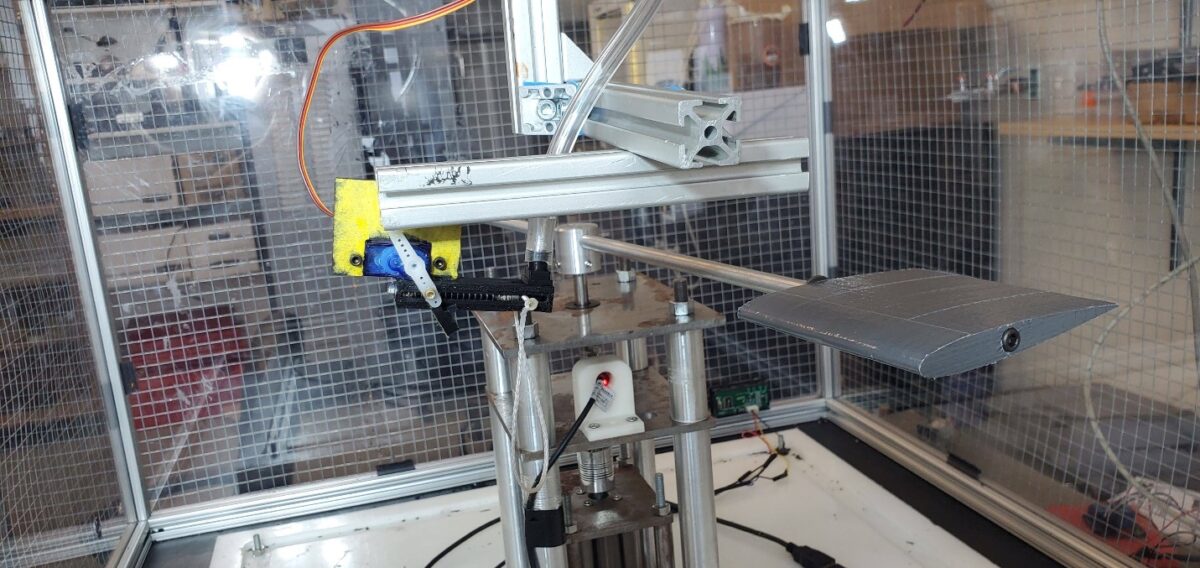
It shoots small particles toward the leading edge of a rotating wing with a thickness of 1 cm and a speed of 60 m/s.
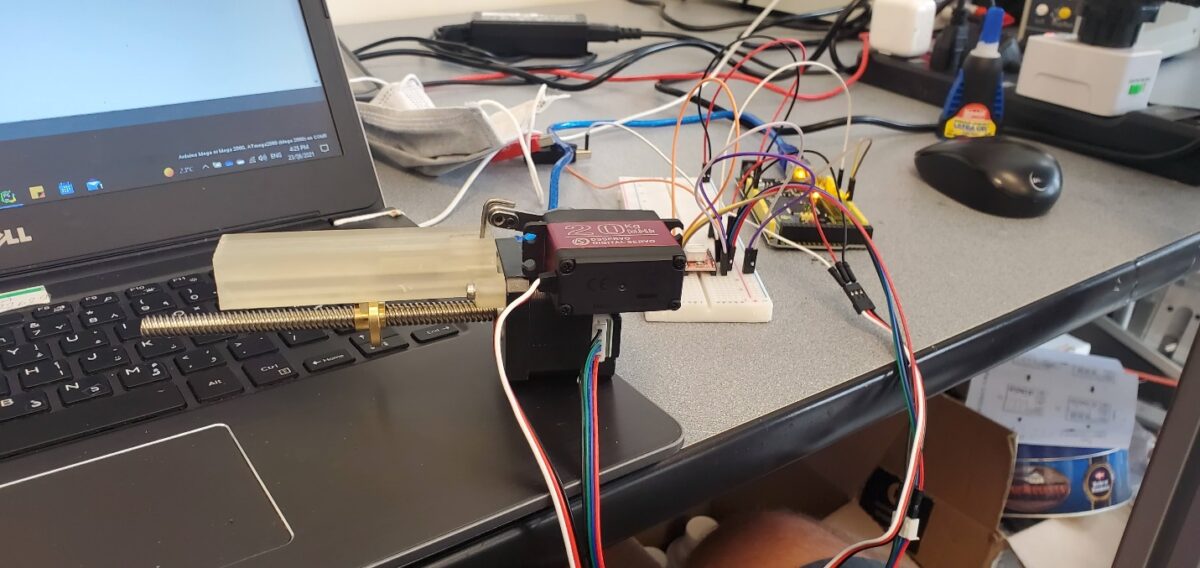
It shoots small particles toward the leading edge of a rotating wing with a thickness of 1 cm and a speed of 60 m/s.
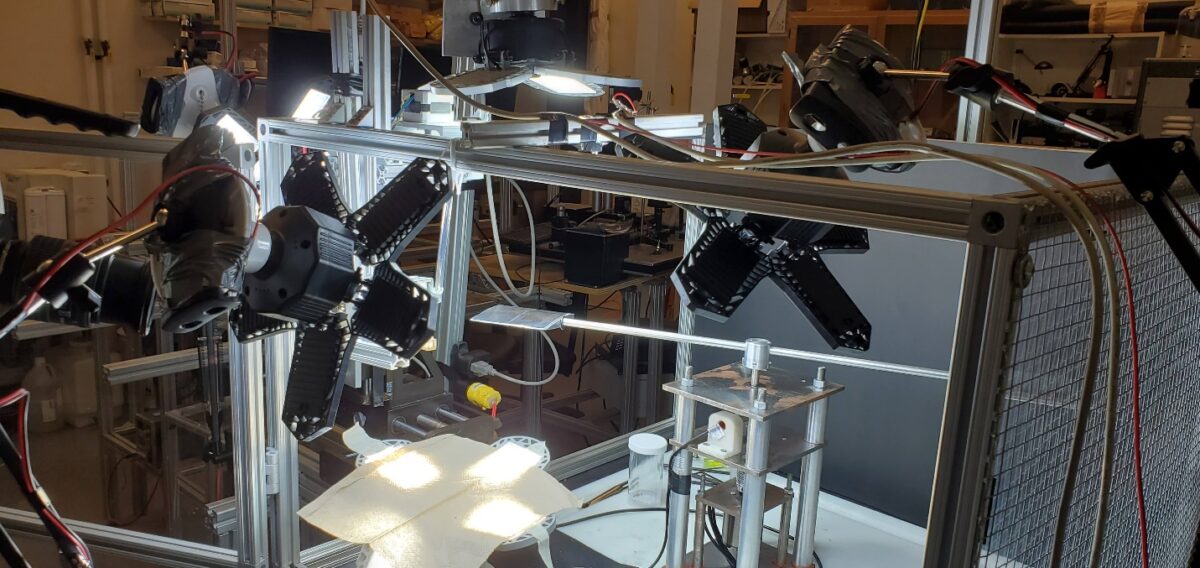
The presented setup simulates the leading edge of the wing of an aircraft with a speed of 60 m/s.
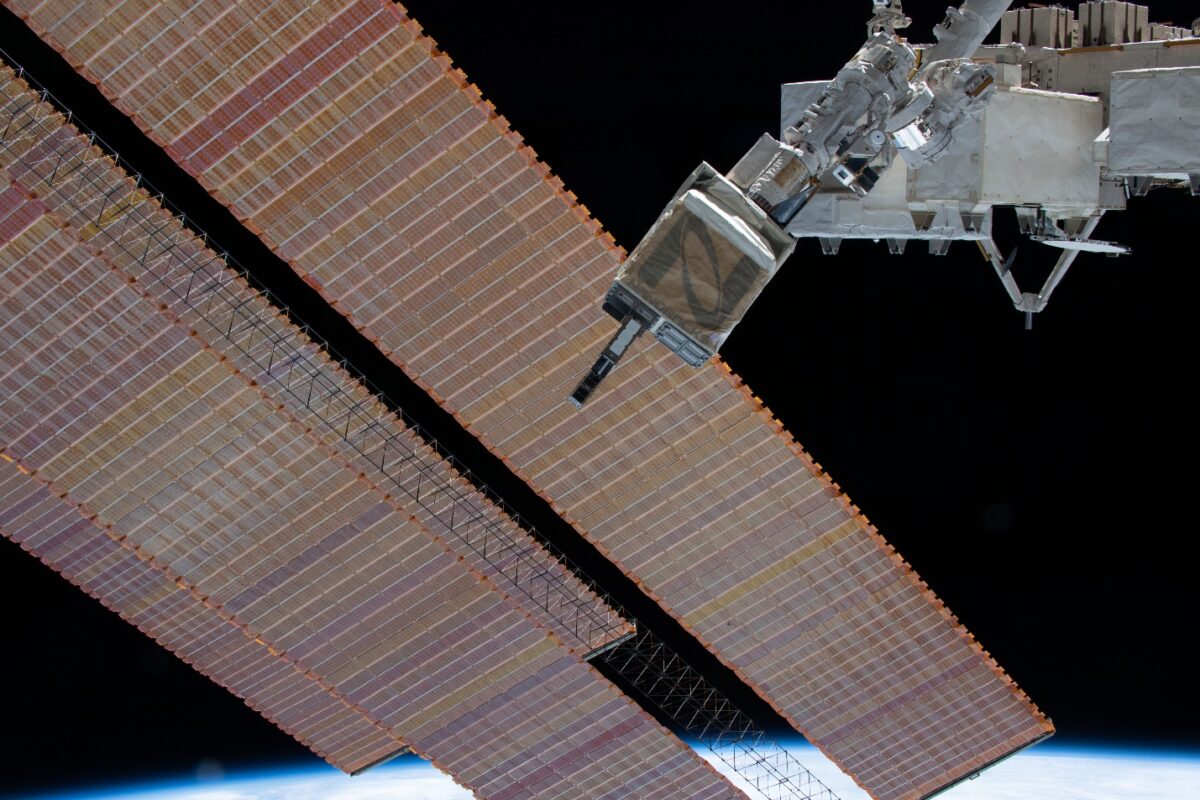
Seconds after our satellite left the International Space Station.
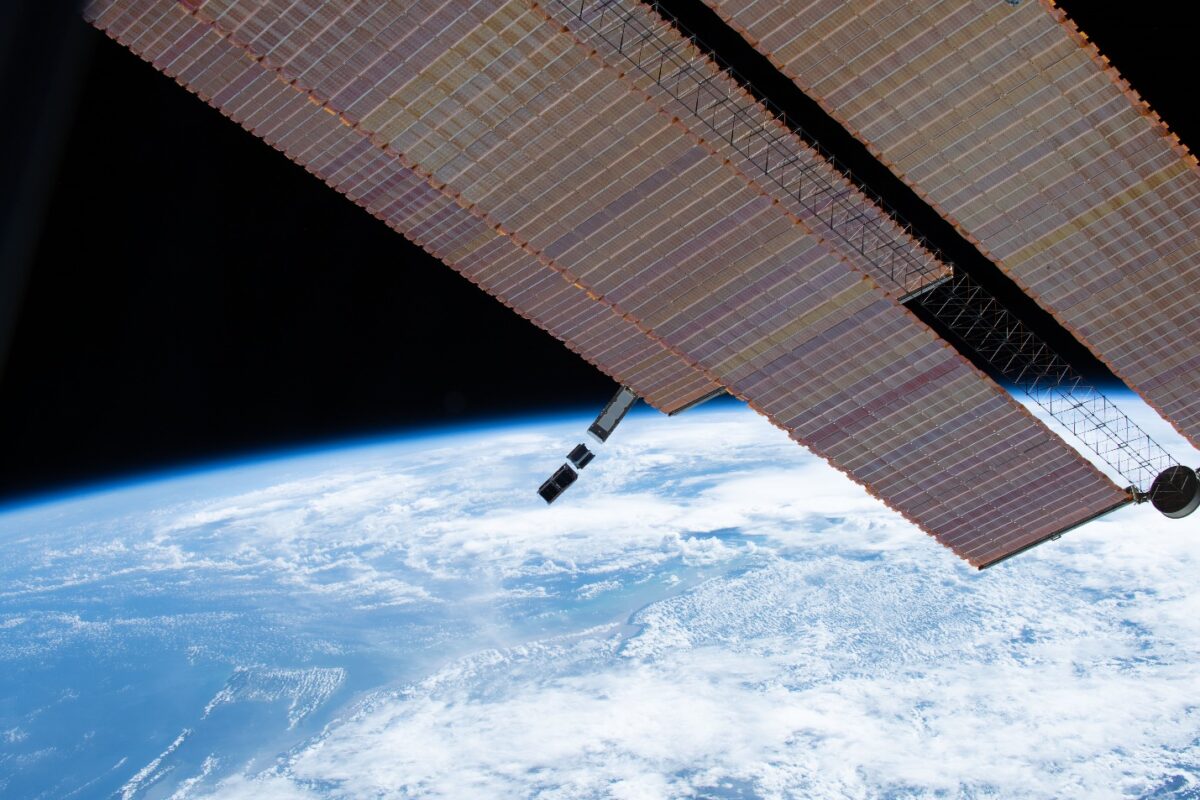
Seconds after our satellite left the International Space Station.
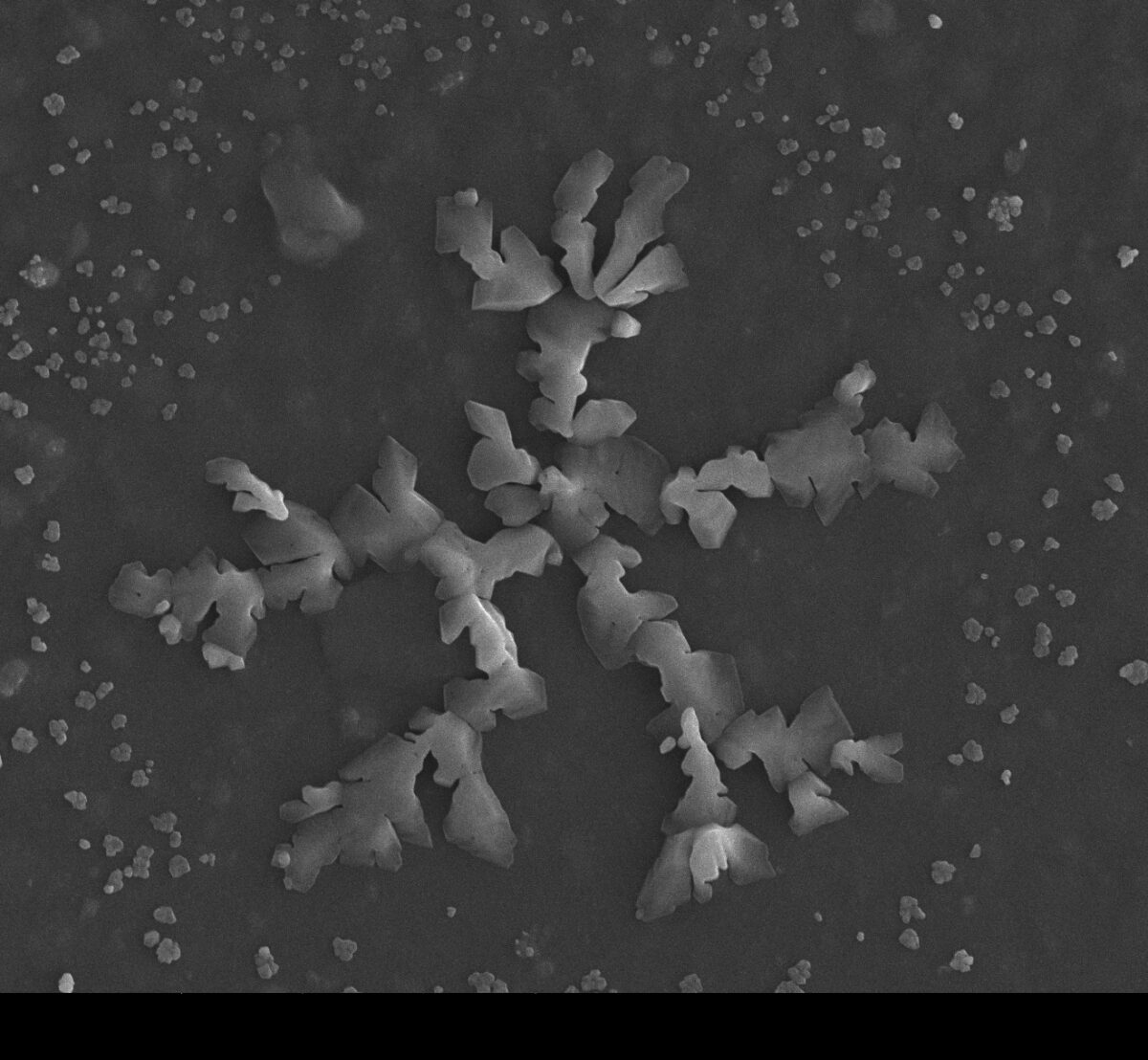
Applying voltage to organic electrochemical transistors (OECTs) can cause dendritic fibers of the semiconducting polymer PEDOT:PSS to form. These dendritic fibers may affect the device’s performance and the plasticity of these fibers can potentially enable neuromorphic computing hardware development.
A field emission scanning electron microscope (FE-SEM) (Thermofisher Quanta 3D) was used for taking this photo.
A field emission scanning electron microscope (FE-SEM) (Thermofisher Quanta 3D) was used for taking this photo.
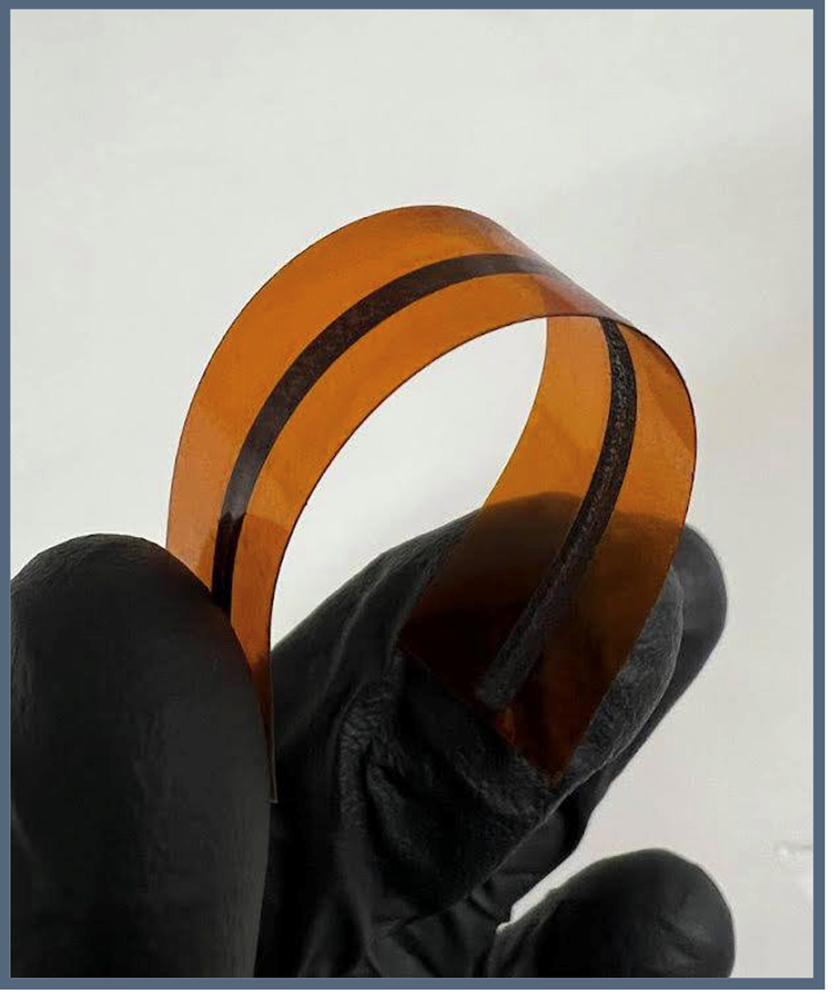
A flexible polymeric substrate can be selectively converted into laser-induced graphene (LIG) in the simplest possible way by using a CO2 laser. It has remarkable properties specifically high surface area, flexibility, and good electrical conductivity. This flexible LIG can be used in roll-to-roll processes, allowing for large-scale, mass production of LIG sheets that might be used in a variety of applications such as sensing or biochemical sensing.
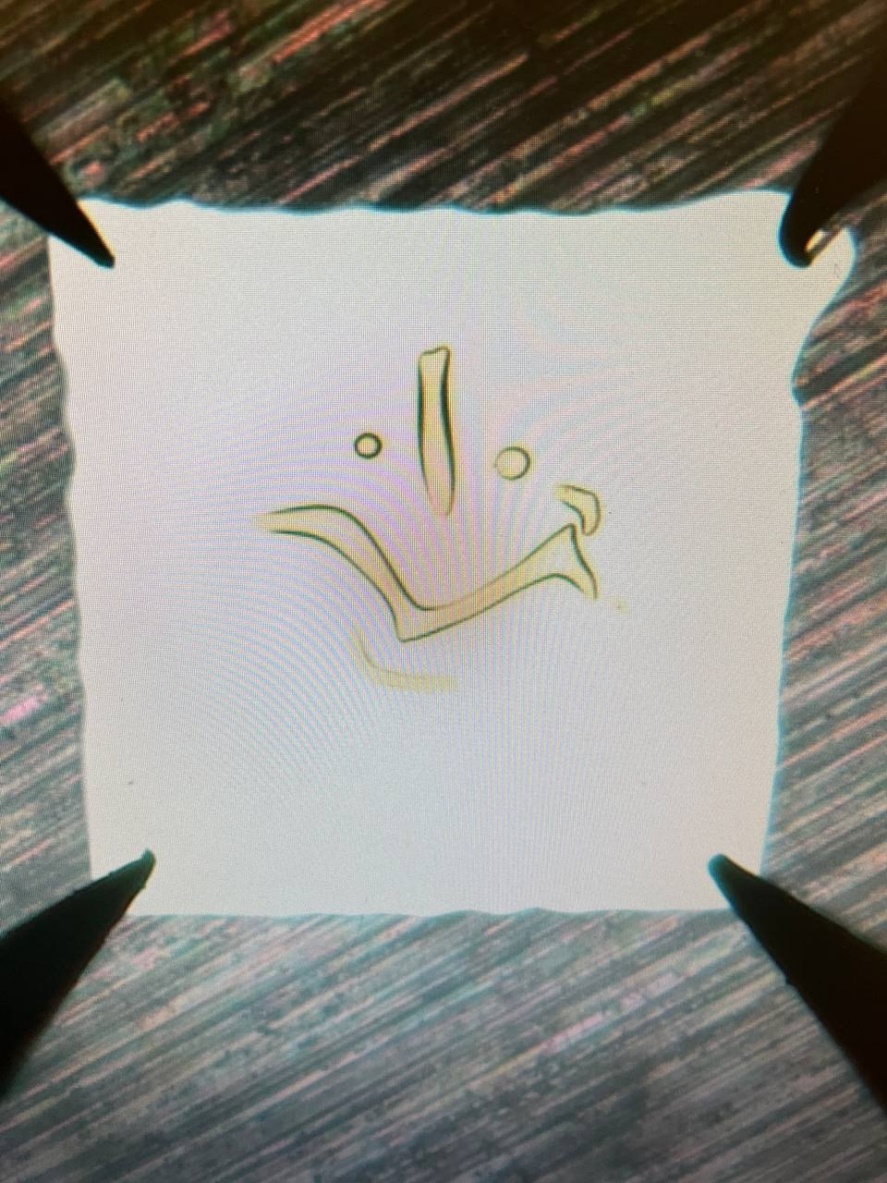
I work on inkjet-printed electrode arrays using silver nanoparticles for applications such as wearable electronics. After printing electrodes, a drying and sintering process is required before electrical characterization. This picture shows a conductive inkjet-printed electrode after drying and intense pulsed light sintering. The smiley face is created after applying 180 light pulses and was found during the electrical resistivity measurement under the microscope when the probe needles touched the corners.
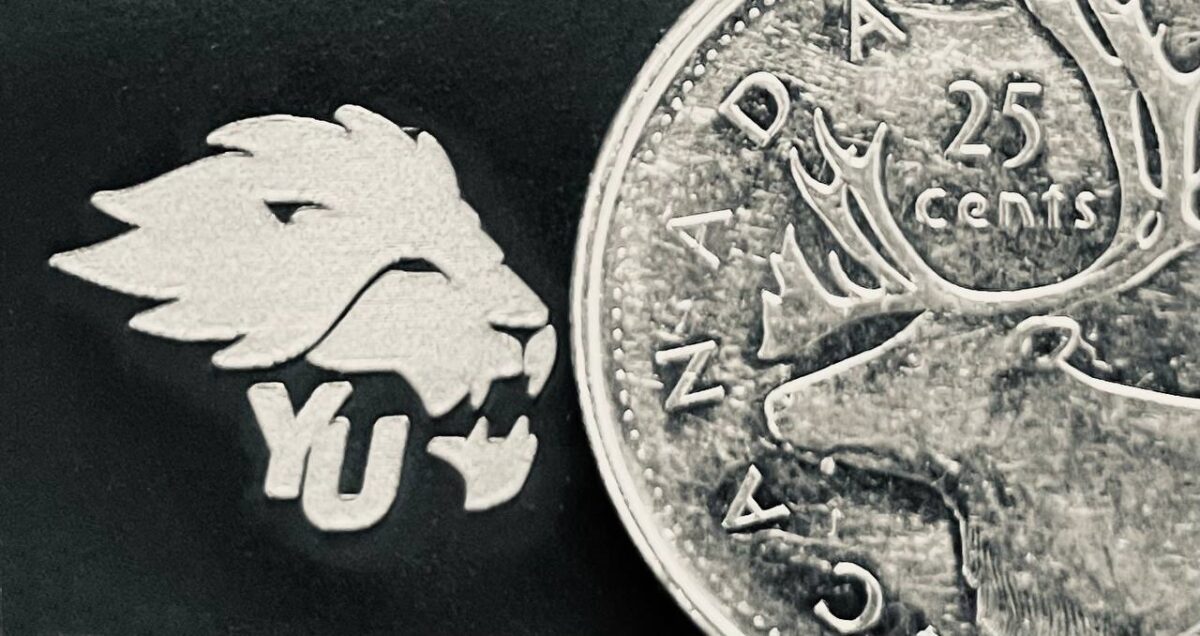
The sharp rise in using electronics has raised concerns about the electronic waste (e-waste) that’s associated with few-use electronics, e.g., TTC daily subway tickets. Using environmentally friendly and carbon-based waste material and the laser beam, we could fabricate transient electronics with high conductivity in case the product can dissolve in water while leaving no harmful effect on the environment. The product consists mostly of Lignin, which is a wood-based waste material, as well as Graphene Oxide, the oxidized form of Graphene. Being facile, low-cost, and bio-friendly, our product can replace conventional metal-based electronics, like coil-shaped RFID tags. In this regard, the bright and conductive York Lion, which is laser-patterned on the black base material in the picture, is fighting a price war with the metal-based quarter reindeer to save the planet.
A laser was used to pattern the York Lion on the material. A phone camera (iPhone 12pro) was used to take the picture. The photo has been retouched using Windows Paint.
A laser was used to pattern the York Lion on the material. A phone camera (iPhone 12pro) was used to take the picture. The photo has been retouched using Windows Paint.
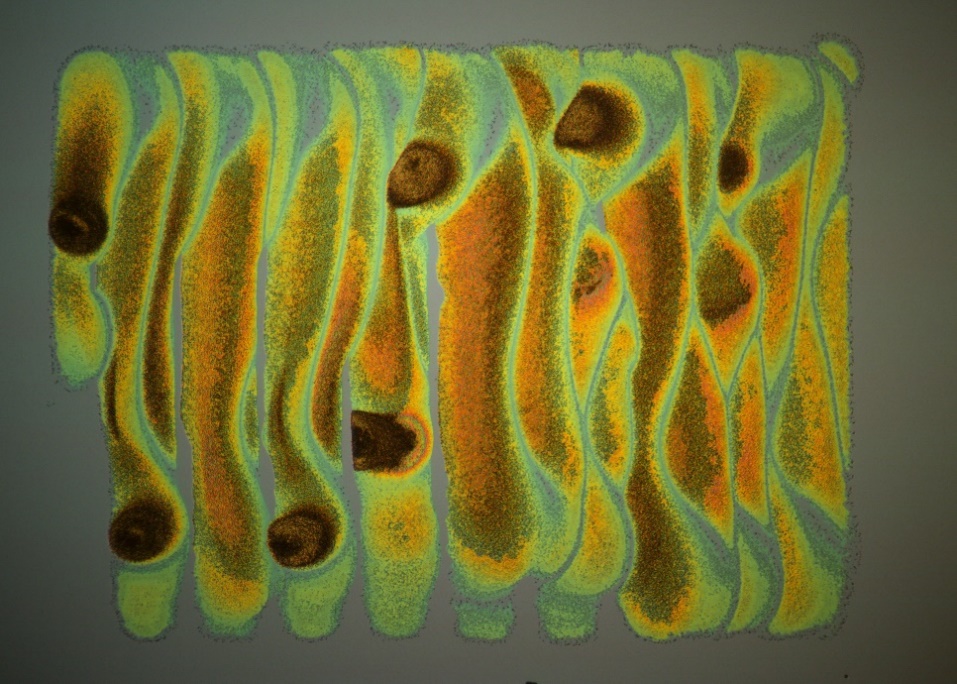
The image shows carbon nanotube (CNT) lines that were produced by micro-inkjet printing CNT ink on a silicon dioxide/silicon wafer. The CNT layer is the semiconducting channel in thin-film transistors (TFTs). CNT-based TFTs have high current and high carrier mobility, which lead to faster circuits. Moreover, CNTs can be easily solution deposited using techniques such as inkjet printing that is low-cost and low-temperature. Our research is to control the direction of the nanotubes using inkjet printing parameters such as the spacing between the printed droplets and lines, and the fluid flow by changing the drying rate of the ink to enhance the performance of the TFTs. The colorful patterns in the image are produced by thickness variations in the CNT film due to fluid flow within the printed lines.
This photo was taken using an OMAX trinocular metallurgical microscope (magnification X4) at the A-EM Lab in the Bergeron building. The image dimensions are 3025 μm X 2270 μm. The photos are presented as taken, and no filters have been used.
This photo was taken using an OMAX trinocular metallurgical microscope (magnification X4) at the A-EM Lab in the Bergeron building. The image dimensions are 3025 μm X 2270 μm. The photos are presented as taken, and no filters have been used.
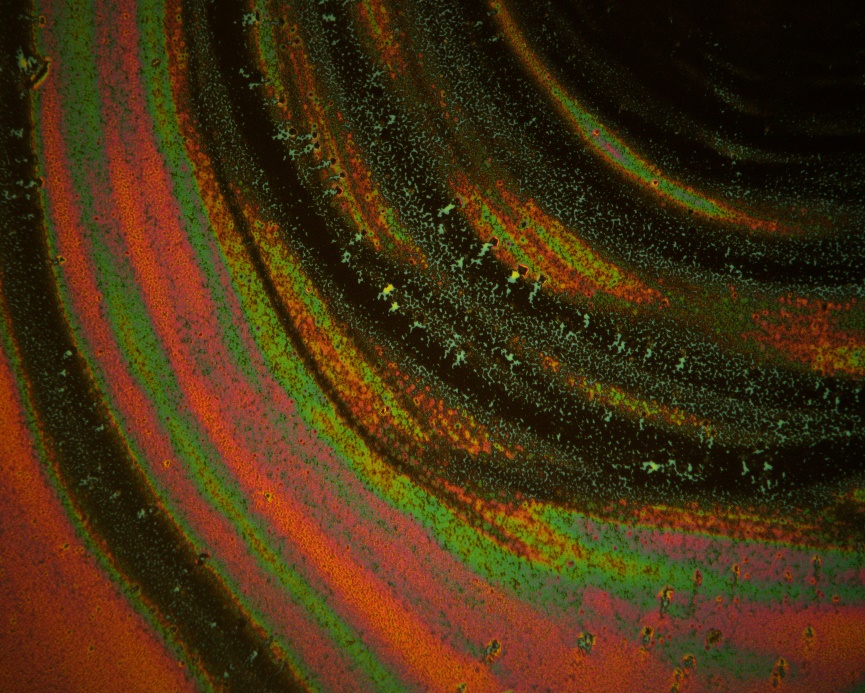
The image shows the non-uniform distribution of an organic semiconductor (TIPS-pentacene) ink that was drop-cast on silicon dioxide and dried at room temperature. The reason for the colored rings appearing on the surface are thickness variations of the semiconductor on the oxide layer. The TIPS-pentacene crystals can be seen on those rings. The deposition of the organic semiconductor is a step in the additive manufacturing process of fabricating organic thin-film transistors (OTFTs). This layer works as the semiconducting channel and this step is followed by inkjet printing the source and drain silver nanoparticle electrodes. Solution-processed electronics is inexpensive and can include the use of a wide range of organic materials that can be chemically and mechanically modified based on the application. Our research is to fabricate high performance OTFTs by solution processing the layers.
This photo was taken using an OMAX trinocular metallurgical microscope (magnification X4) at the A-EM Lab in the Bergeron building. The image dimensions are 3025 μm X 2270 μm. The photos are presented as taken, and no filters have been used.
This photo was taken using an OMAX trinocular metallurgical microscope (magnification X4) at the A-EM Lab in the Bergeron building. The image dimensions are 3025 μm X 2270 μm. The photos are presented as taken, and no filters have been used.
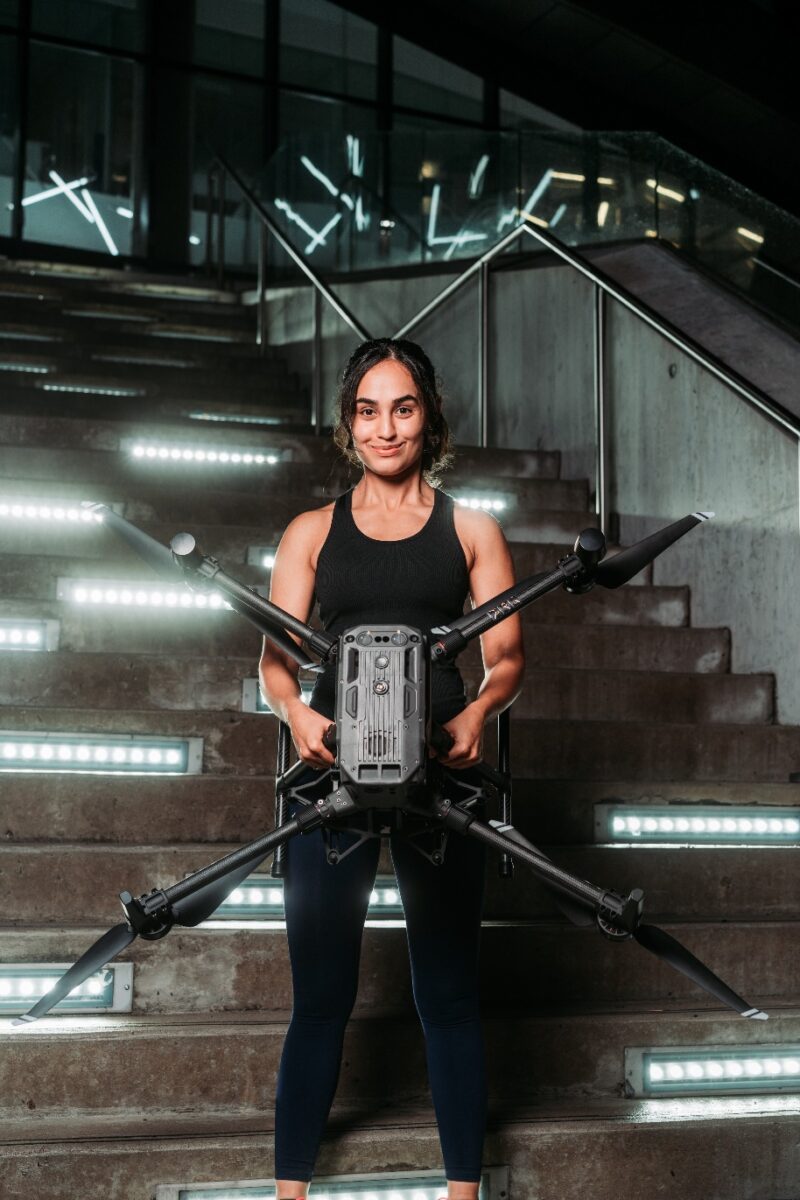
The research presented is part of a CSA (Canadian Space Agency) grant to develop and verify a GNSS-R (Global Navigation Satellite System-Reflectometry) soil moisture monitoring payload that can be easily integrated in an Unmanned Aerial Vehicle (UAV), to provide a low-cost alternative to in-situ measurements and as a precursor to a space mission.
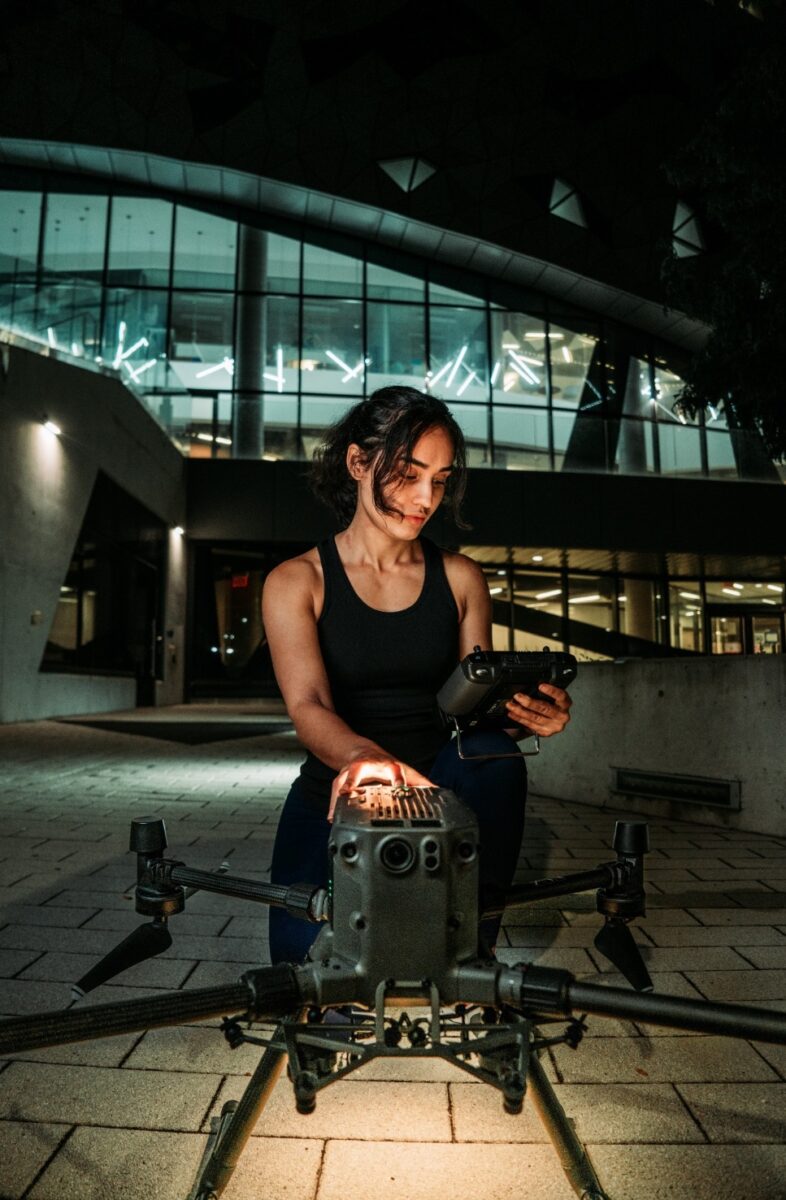
The research presented is part of a CSA (Canadian Space Agency) grant to develop and verify a GNSS-R (Global Navigation Satellite System-Reflectometry) soil moisture monitoring payload that can be easily integrated in an Unmanned Aerial Vehicle (UAV), to provide a low-cost alternative to in-situ measurements and as a precursor to a space mission.
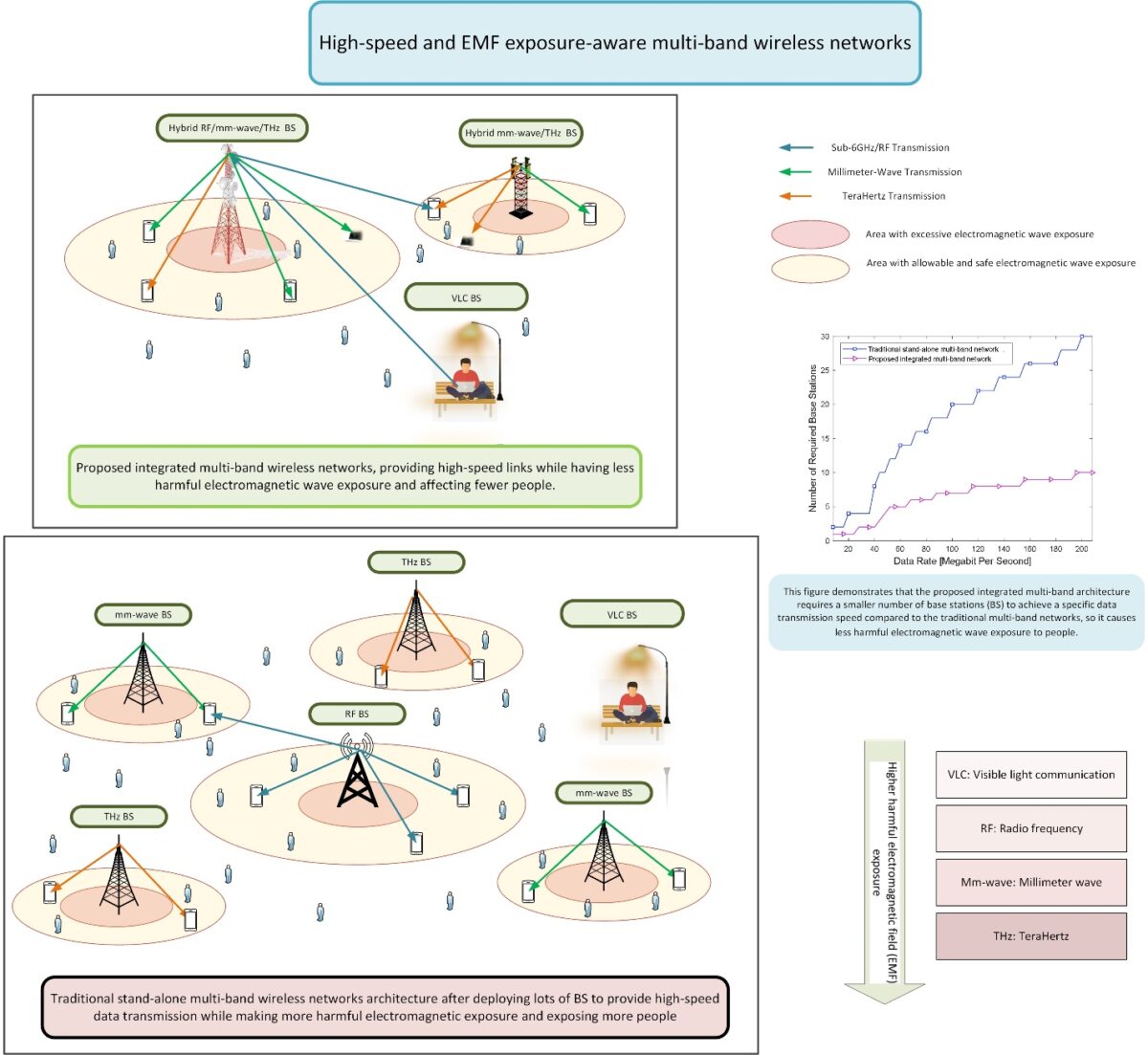
This picture demonstrates a proposed multi-band wireless network architecture and its capability to reduce electromagnetic field exposure (EMF). This vital concern impacts human health and is a critical parameter that needs to be considered in future wireless system generation, 6G. Multi-band networks in 5G use different frequency spectrums to offer a better data rate to users. It must be mentioned that EMF limits are distinct for various frequencies. Similar to traditional multi-band networks, our proposed integrated architecture can provide high data rates while using a smaller number of base stations, which results in decreasing EMF levels.
The picture and the system model are created using Microsoft Visio. The simulation plot results from a programmed simulation, and MATLAB is used for programming and plotting the figure.
The picture and the system model are created using Microsoft Visio. The simulation plot results from a programmed simulation, and MATLAB is used for programming and plotting the figure.
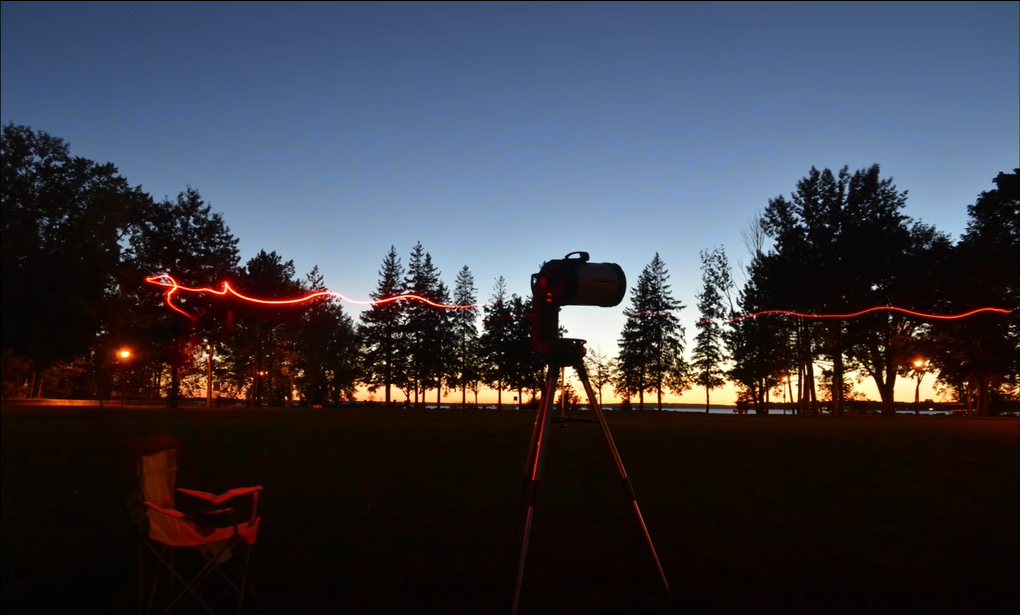
Space Situational Awareness (SSA) involves the study of objects orbiting Earth. Students learn the tools and produce data to benefit ongoing research involving SSA. Photometric characteristics involve how the light obtained from the satellite deviates over time, which helps with predicting satellite orientation & shape. On the other hand, astrometric measurements involve the location of the satellite relative to the neighbouring stars in an image. Continuously measuring these characteristics provides information for orbital determination. Knowing the orbit of satellites is very important due to the increasing risk of satellite collisions. Learning the tools and producing photometric and astrometric measurements allows us to ensure longevity of Canadian based satellites. Sensors of various sizes are being tested and used by students to capture specific satellite targets for SSA purposes.
A 10-second exposure obtained from a DSLR shows a telescope being set up for a SSA multi-site observation campaign.
A 10-second exposure obtained from a DSLR shows a telescope being set up for a SSA multi-site observation campaign.
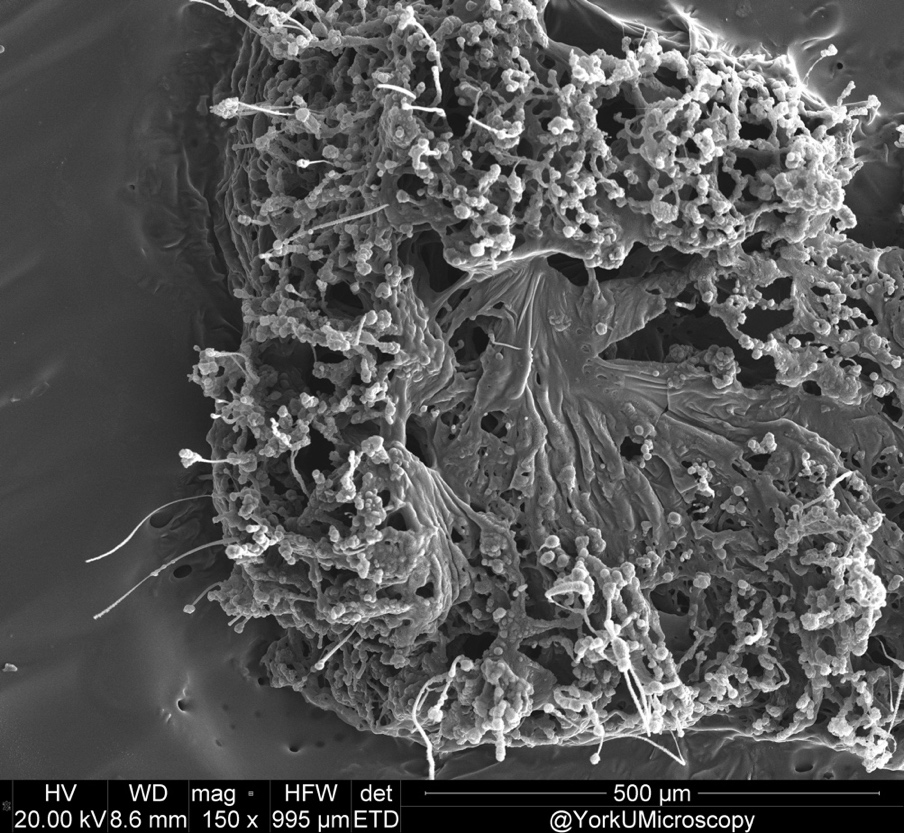
Lasering the 3D printed polysulfone substrate via CO2 laser leads to creating naturally sulfur-doped embedded graphene coatings. Both using the PSU-class polymers and 3D printed substrate could be helpful in using the created LIG in various applications such as biomedical, water treatment, and energy storage devices. The photos below represent the morphology of LIG fabricated on PSU 3D-printed substrate.
A field emission scanning electron microscope (FE-SEM) (Thermofisher Quanta 3D) was used for taking these photos.
A field emission scanning electron microscope (FE-SEM) (Thermofisher Quanta 3D) was used for taking these photos.
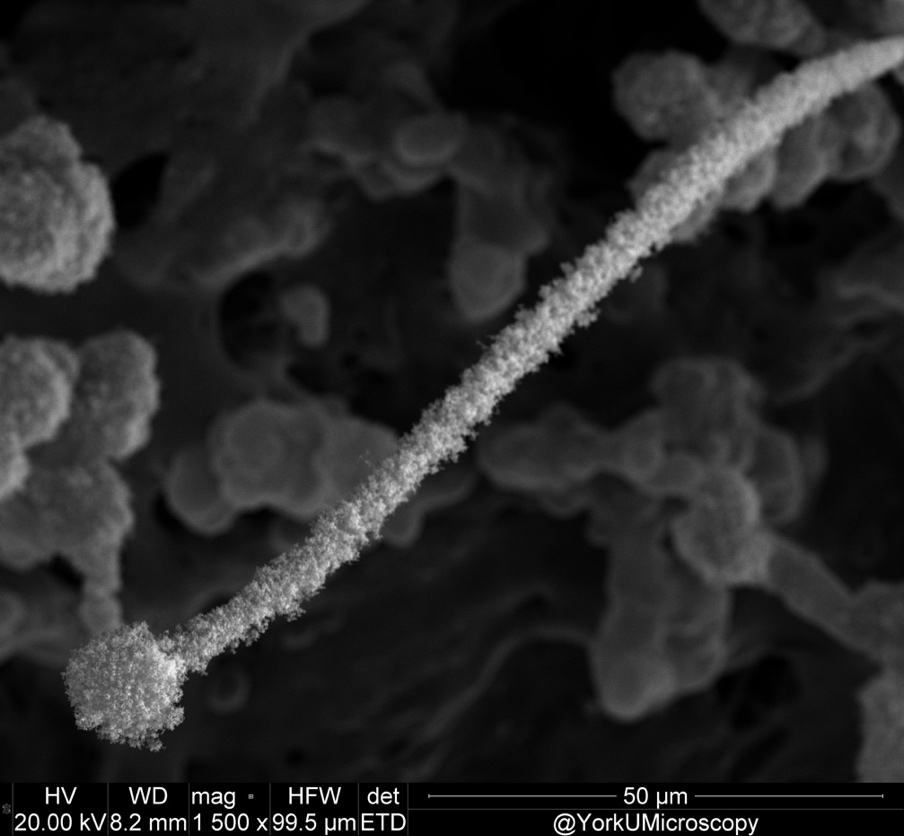
Since the polysulfone substrate is able to be transformed to LIG via using CO2 laser, the investigation of the LIG morphology and its growth could be important. It seems that in addition to the spherical shape that it has, the longer LIG is observed in some area of the LIG line.
A field emission scanning electron microscope (FE-SEM) (Thermofisher Quanta 3D) was used for taking these photos.
A field emission scanning electron microscope (FE-SEM) (Thermofisher Quanta 3D) was used for taking these photos.
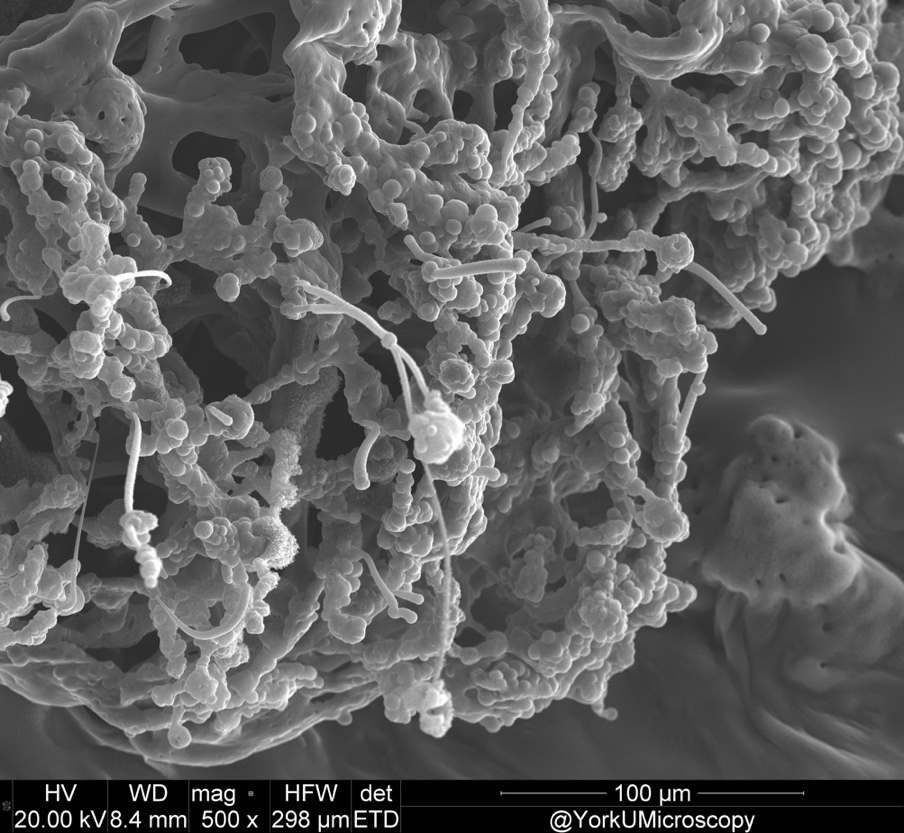
The spherical morphology is the dominant part of the LIG morphology fabricated on 3D printed polysulfone. It seems that the chemical composition of the polysulfone substrate helps LIG to grow in a line-patterned morphology.
A field emission scanning electron microscope (FE-SEM) (Thermofisher Quanta 3D) was used for taking these photos.
A field emission scanning electron microscope (FE-SEM) (Thermofisher Quanta 3D) was used for taking these photos.
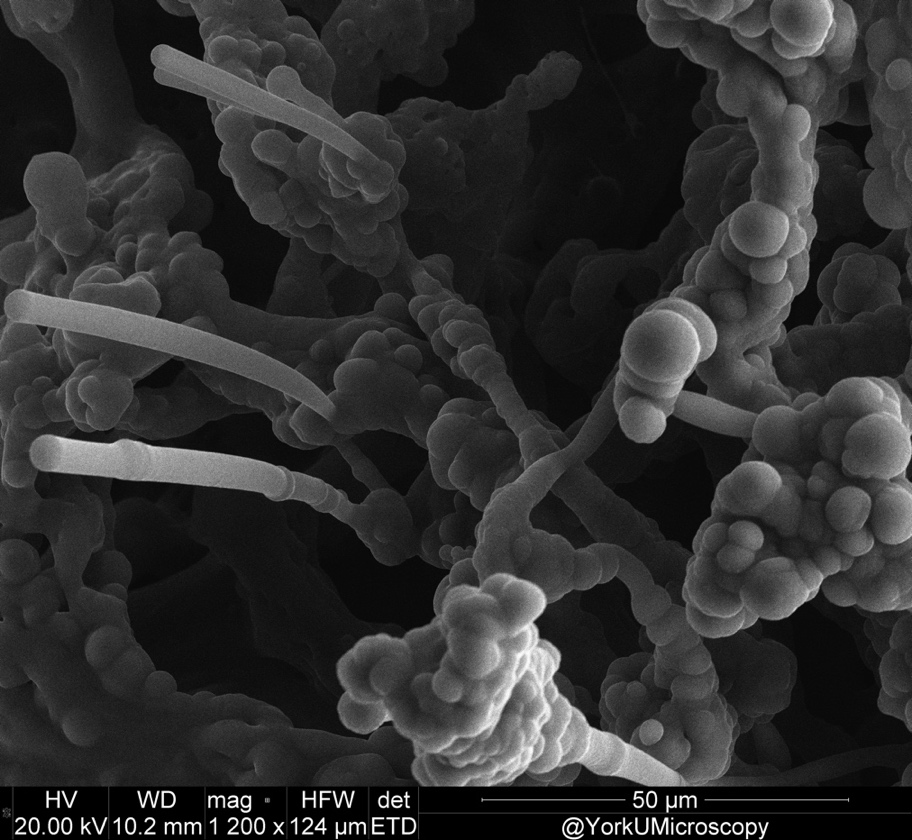
The study of the LIG morphology and its growth may be crucial since the polysulfone substrate can be converted to LIG using a CO2 laser. It appears that in some regions of the LIG line, in addition to the spherical shape it has, the lengthier LIG is seen.
A field emission scanning electron microscope (FE-SEM) (Thermofisher Quanta 3D) was used for taking these photos.
A field emission scanning electron microscope (FE-SEM) (Thermofisher Quanta 3D) was used for taking these photos.
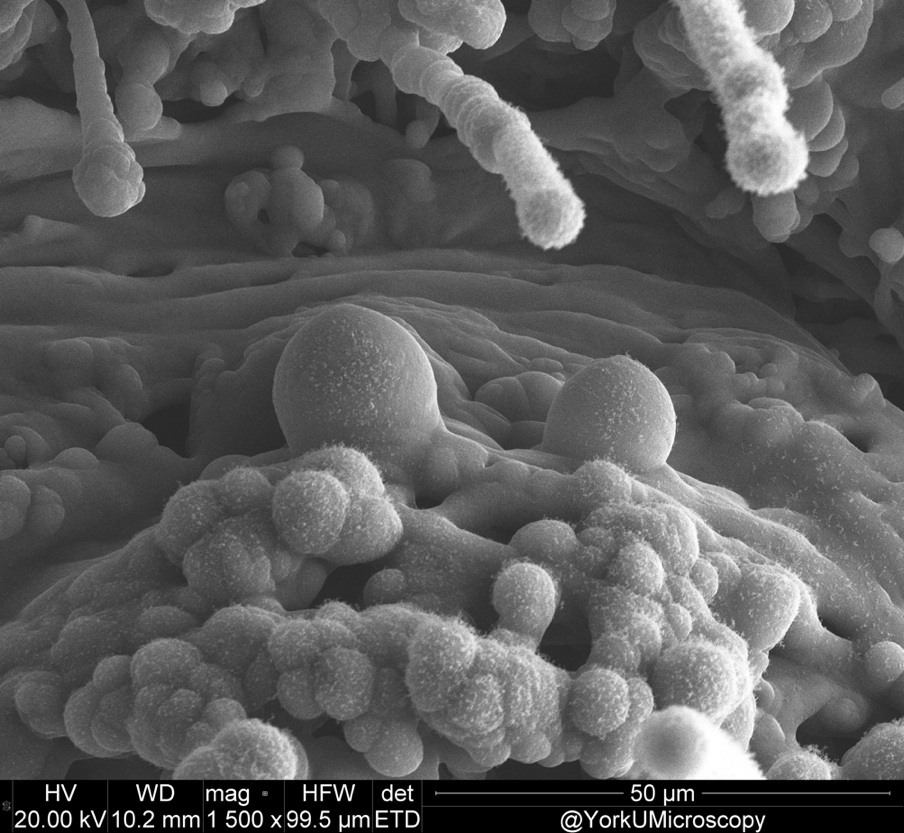
The LIG shape and its growth may be crucial since the 3D printed polysulfone (PSU) substrate can be converted to LIG using a CO2 laser. It appears that in addition to its spherical shape, the lengthier LIG is also seen in some areas of the LIG line.
A field emission scanning electron microscope (FE-SEM) (Thermofisher Quanta 3D) was used for taking these photos.
A field emission scanning electron microscope (FE-SEM) (Thermofisher Quanta 3D) was used for taking these photos.
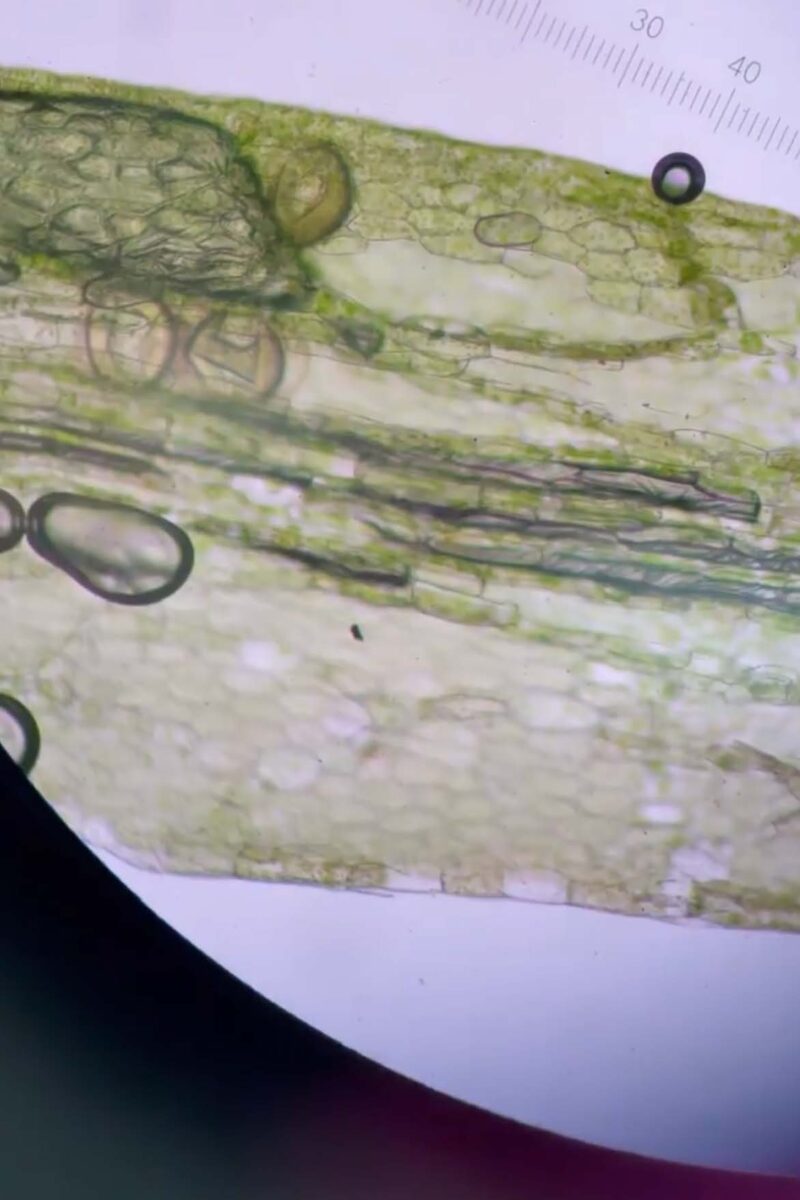
As seen in the photo the epidermis cells show a clear collapse of the epidermal membrane of the cell resulting in loss of water in presence and resulting in the cell to shrink. Further, a glare of the readings of the scale can be observed giving an idea of what scale of size is being dealt by the microscope (10 to the power -4 m of radius).
The following photo has been clicked during the Winter semester in the Life Sciences building during BIOL 1000 lab on Plasmolysis in Plant cells.
The following photo has been clicked during the Winter semester in the Life Sciences building during BIOL 1000 lab on Plasmolysis in Plant cells.

Airborne transmission of respiratory droplets is one of the major routes of spreading infectious diseases. The image demonstrates the transmission of cough aerosol in an upward-moving escalator. The cough droplets expelled from the mouth entered the recirculation zones via the upper portion of the shoulder and wake zone behind the torso. It is also seen that the hand railings are one of the most susceptible contaminated surfaces to the expelled respiratory droplets. Dispersion of cough aerosol is different with different escalator operational speeds. The droplets travel further down behind the infected passenger at a higher escalator velocity. Another individual can become infected by inhaling these droplets or by touching a contaminated surface as a result of the aerosol droplets’ deposition.
The image was obtained using the computational fluid dynamics (CFD) method with ANSYS FLUENT. The Eulerian-Lagrangian method combined with two-way coupling was carried out in multiphase simulation. Two separate simulations gave the image containing the dispersion of cough droplets for the escalator operational speed of 0.4 m/s, and 0.6 m/s at 54% relative humidity. A total of 144 hours (time of two separate simulations) were needed to generate this image.
The image was obtained using the computational fluid dynamics (CFD) method with ANSYS FLUENT. The Eulerian-Lagrangian method combined with two-way coupling was carried out in multiphase simulation. Two separate simulations gave the image containing the dispersion of cough droplets for the escalator operational speed of 0.4 m/s, and 0.6 m/s at 54% relative humidity. A total of 144 hours (time of two separate simulations) were needed to generate this image.
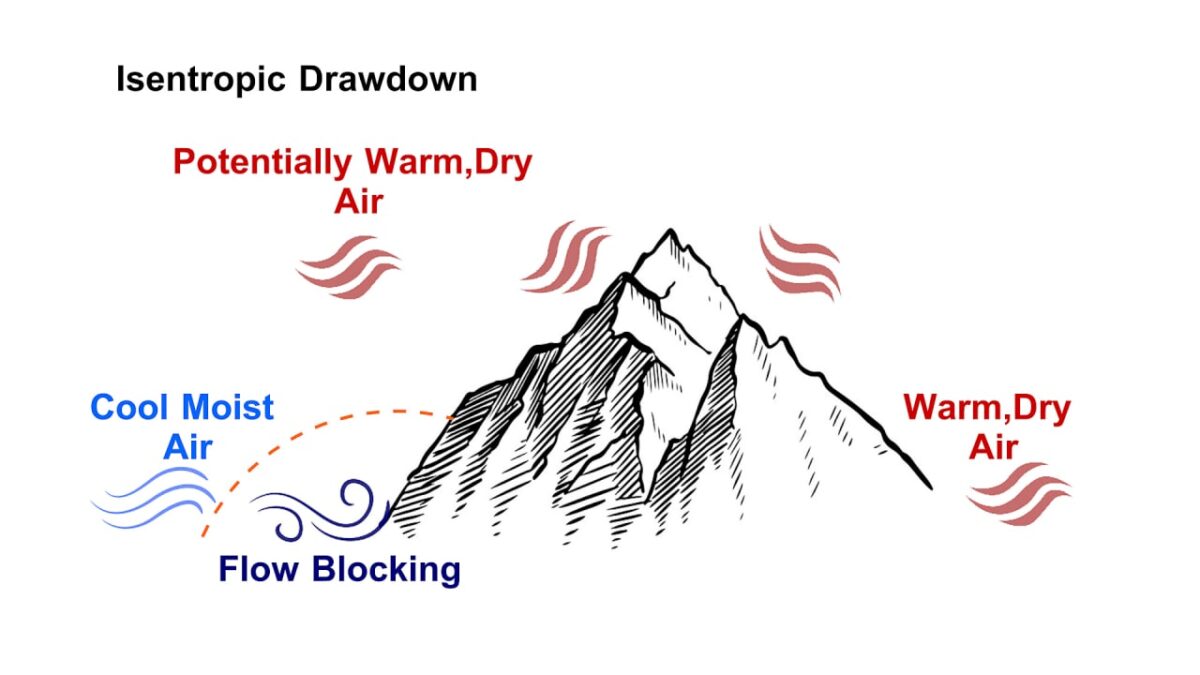
This condition happens when upwind of the mountain, cool, moist air (here westerly) can be blocked. This mechanism allows potentially warmer, drier air to be advected isentropically[1] down the lee slopes. It is a nonlinear mechanism which happens when the wind speed is insufficient for ascent from a low level over the mountains.
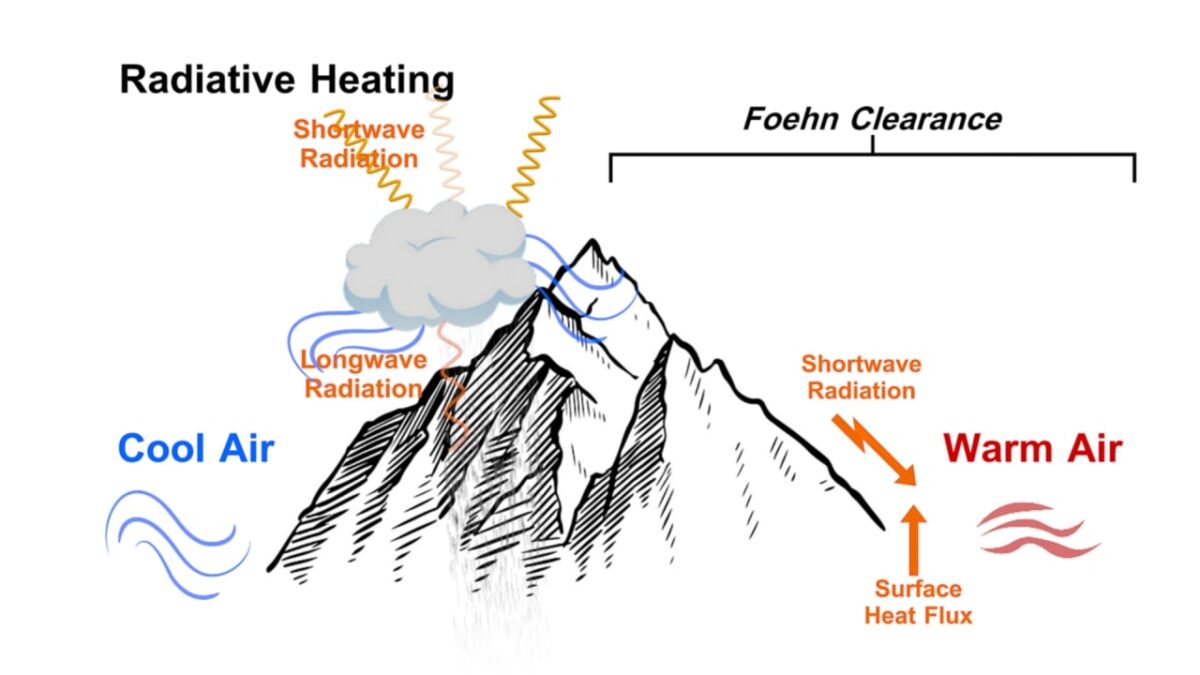
There is a combination of the three described mechanisms. There is often dry, clean, warm air on the leeward side which can make “Foehn Clearance.” Mostly there is a cloud on the windward slope with a probability of precipitation. Orographic has a significant role in this foehn mechanism which forces the air to move upward.
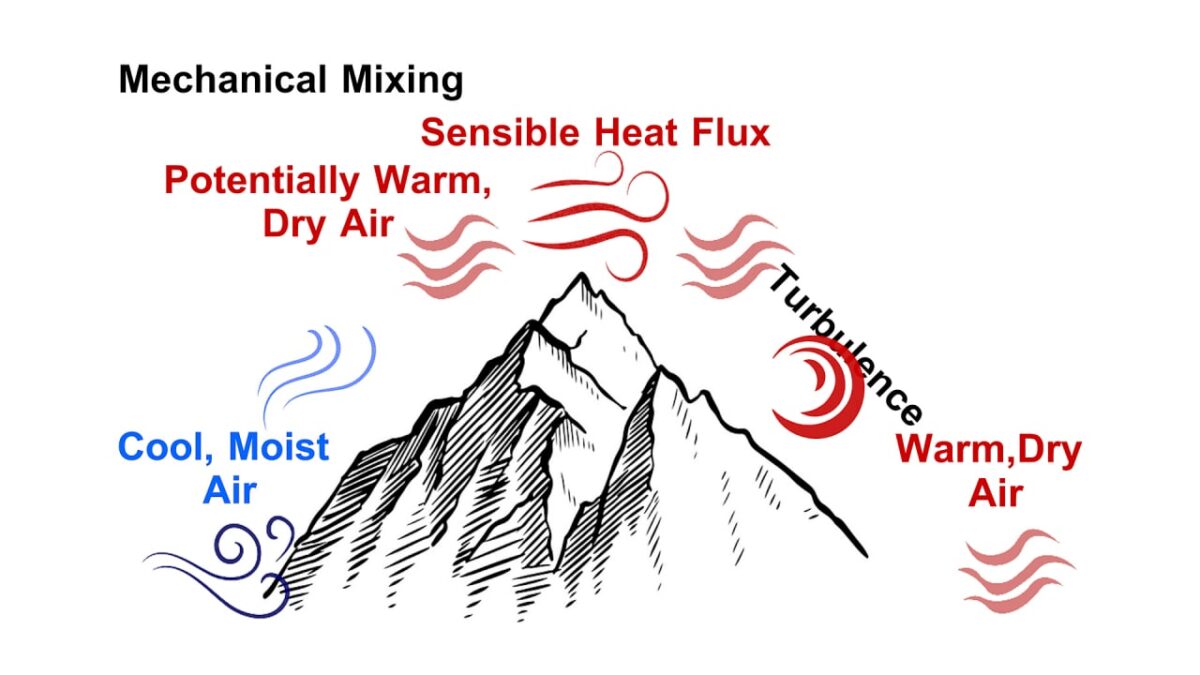
The cool, moist air passes over the mountain; it will mix mechanically with the overlying air mass, potentially warmer and drier. Then a turbulent flux of sensible heat and turbulent flux of moisture originates the foehn wind.
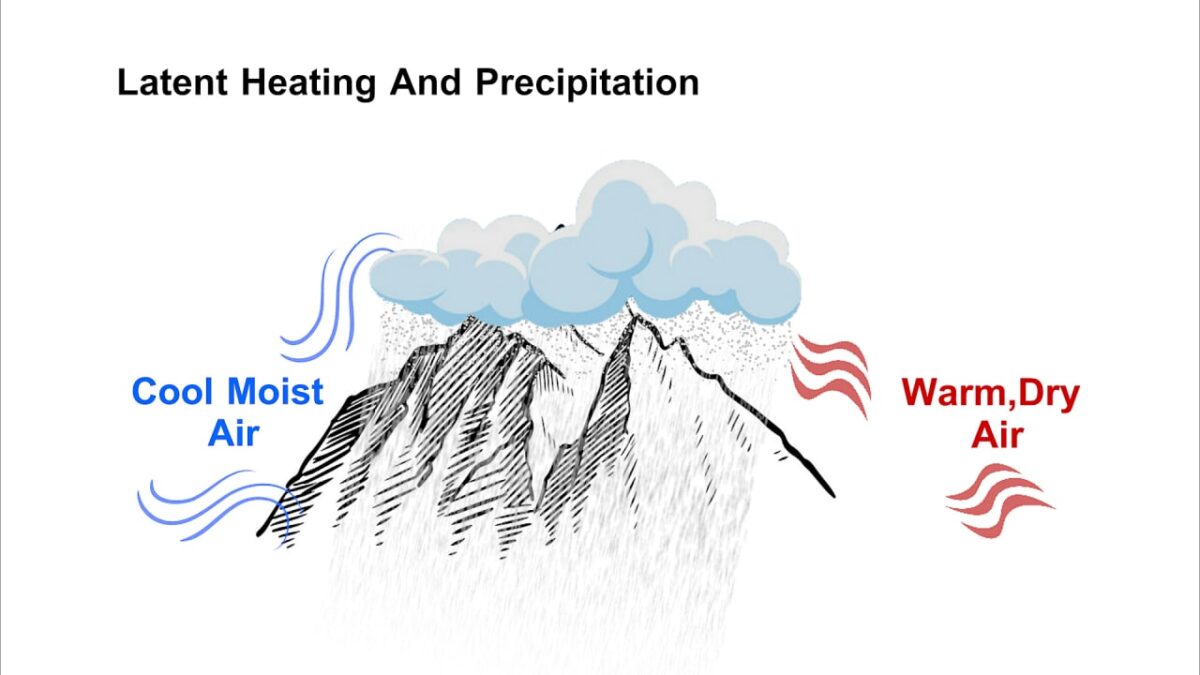
This mechanism is the classic definition of the foehn wind. On the windward, there is rising, cool, moist air, which can make precipitation at the height. On the leeward, the warm, dry air has lost its moisture downward the mountain.

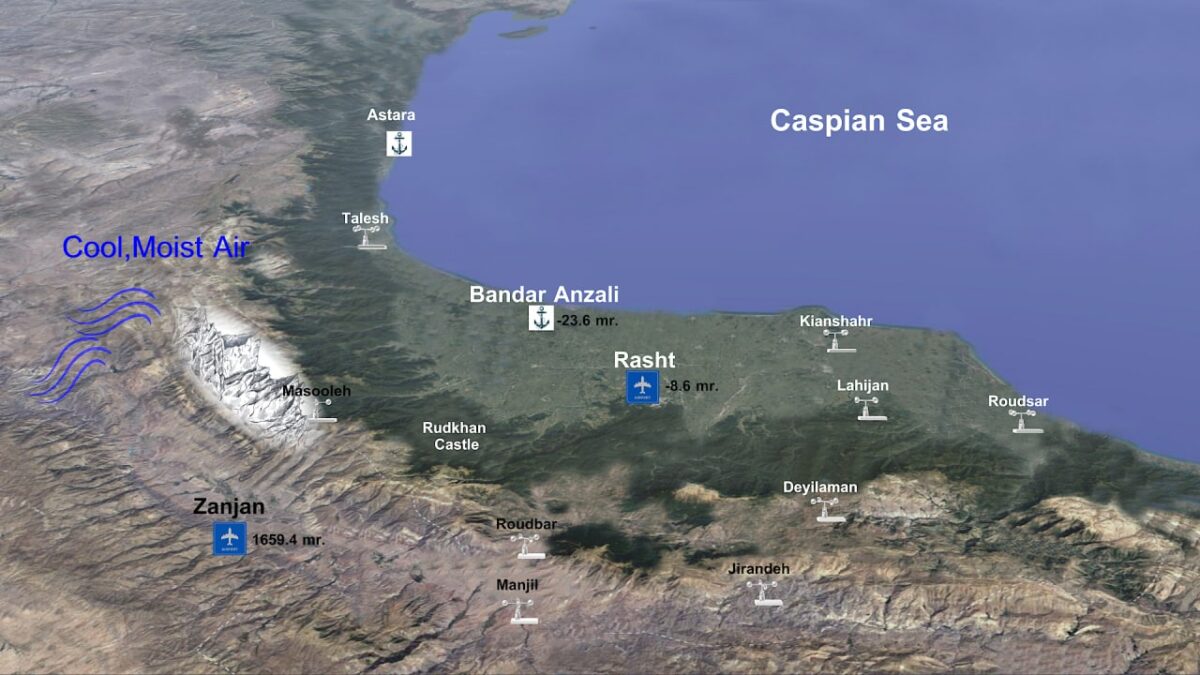
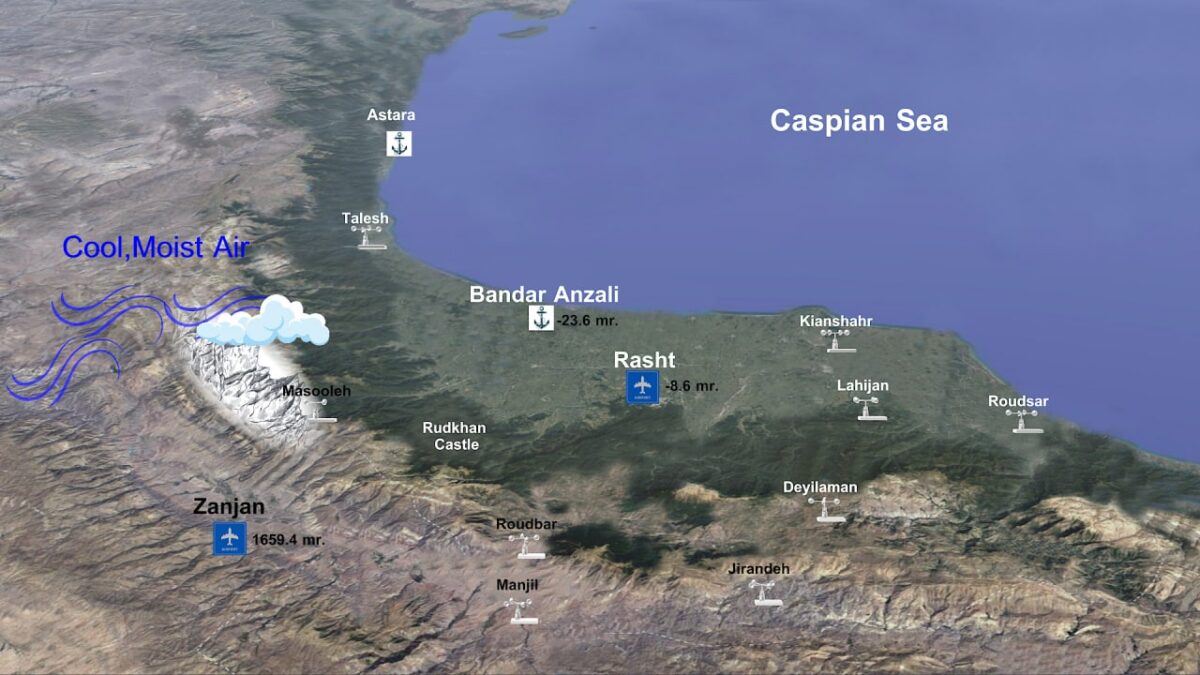
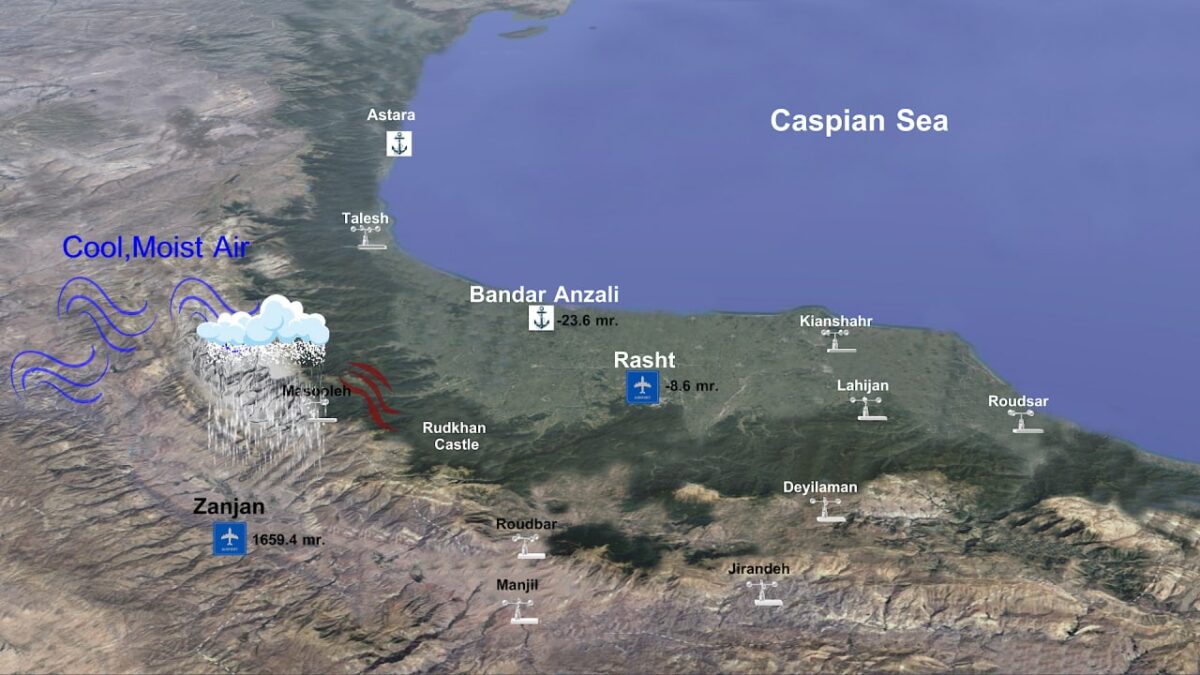
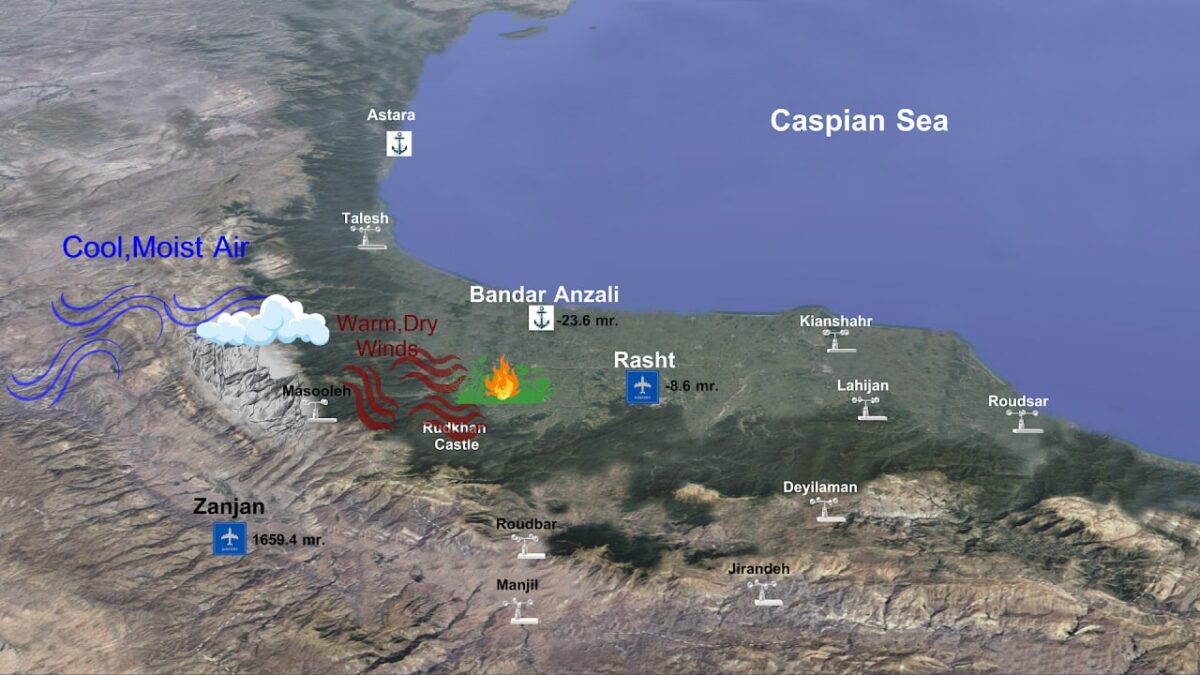
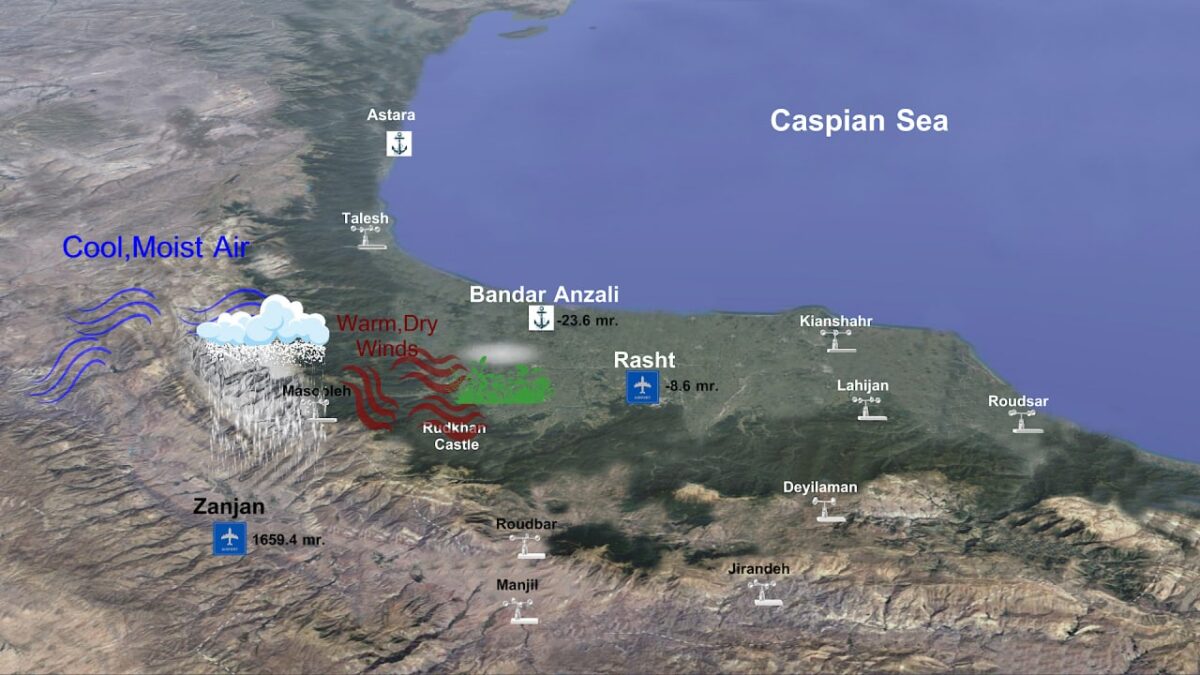
Warm and dry foehn winds can significantly affect human life in mountainous regions worldwide. Foehn’s features include rising temperature, dropping relative humidity, and a fixed direction high wind commencement. Iran, a mountainous country, is affected by foehn in many places. The Caspian Sea borders are in the north, the northern area of Iran, and in the south, the Alborz Mountains in the south are the Caspian Sea Borders. The southwest part of the Caspian Sea coastal area is displayed here. Large amplitude mountain waves have occurred and caused severe wildfires in the Caspian forests.
These photos demonstrate that foehn events can occur due to high pressure over the interior regions and a lee cyclone over the southern Caspian Sea, with a strong south-north pressure gradient across the Alborz Mountains. A typical wind event will be used to illustrate this foehn situation.
Images generated by using 3d Studio Max, Adobe Photoshop, Adobe Premiere
These photos demonstrate that foehn events can occur due to high pressure over the interior regions and a lee cyclone over the southern Caspian Sea, with a strong south-north pressure gradient across the Alborz Mountains. A typical wind event will be used to illustrate this foehn situation.
Images generated by using 3d Studio Max, Adobe Photoshop, Adobe Premiere